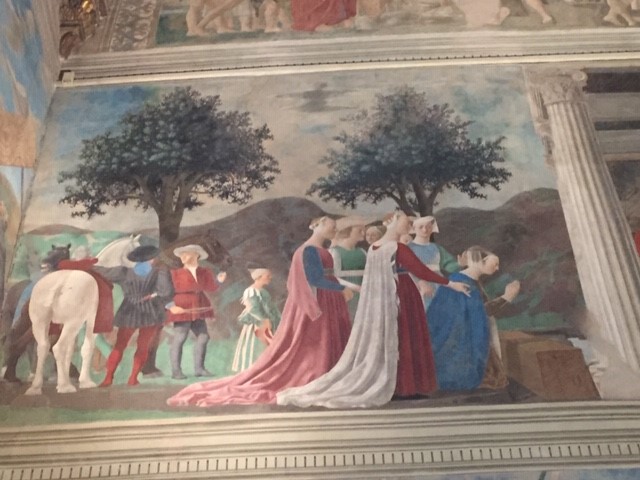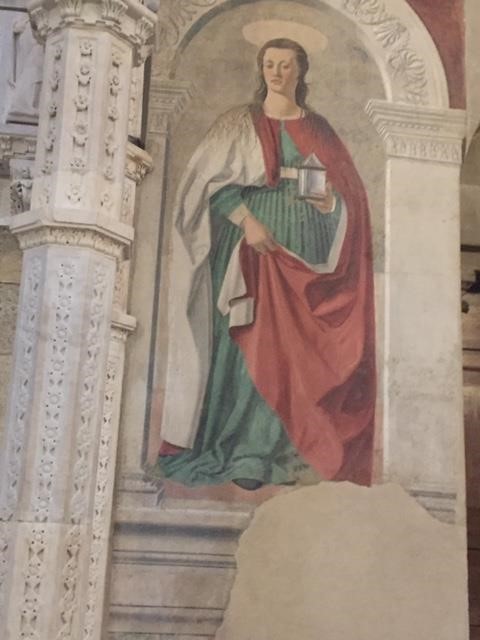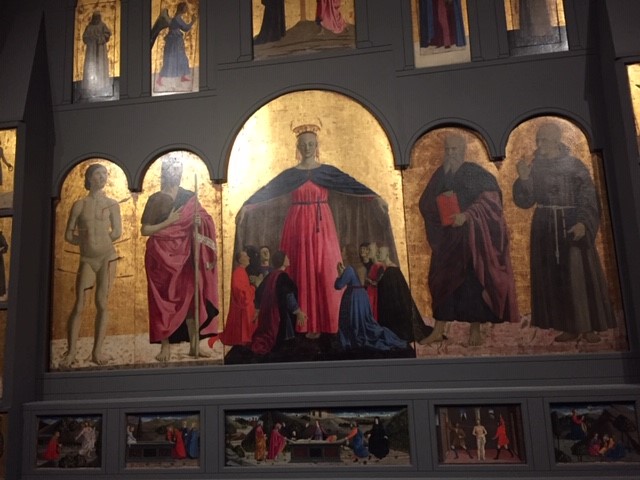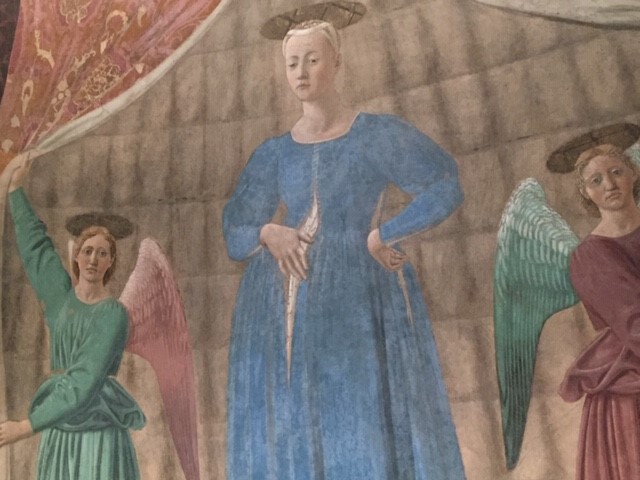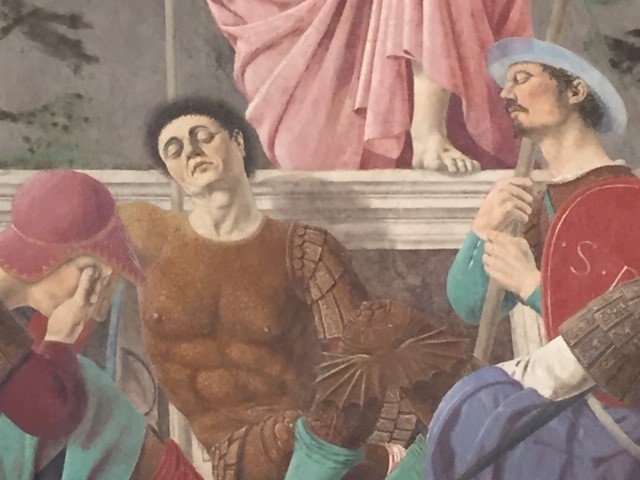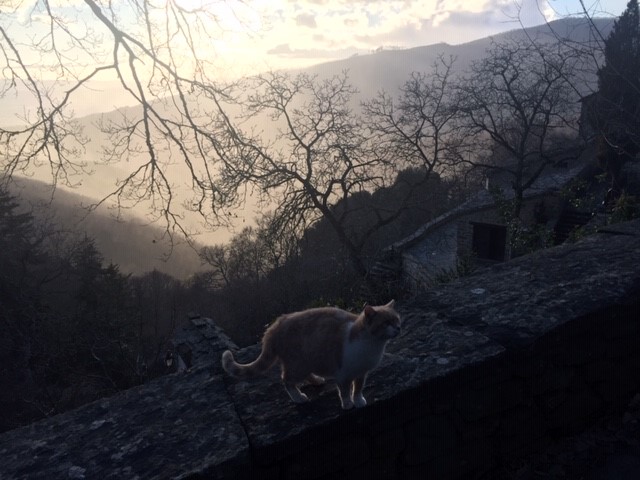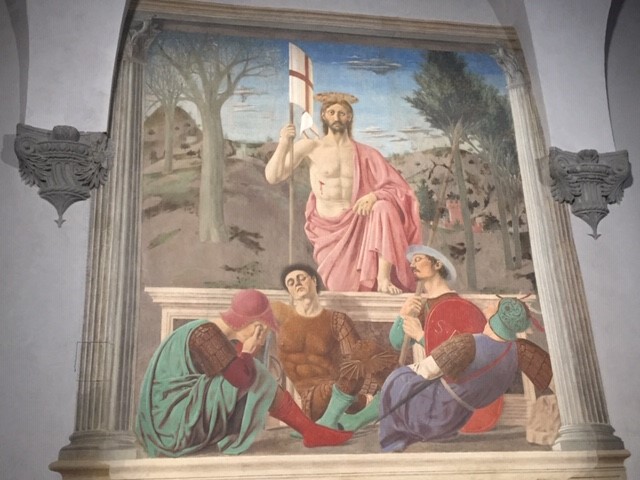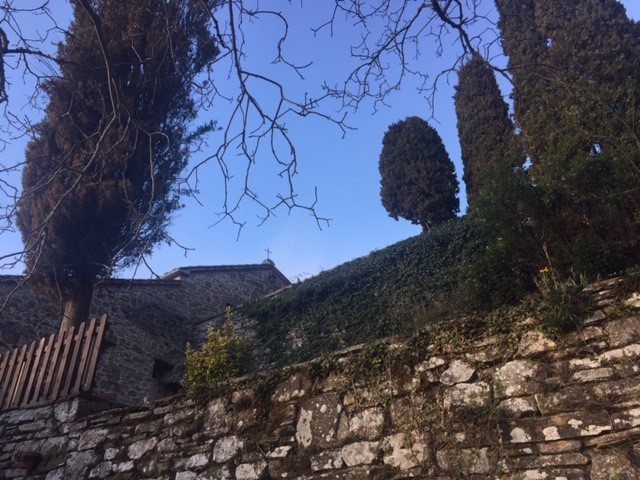The Piero Tour in Italy
Bernie Langs
While familiarizing myself over the years with the pictures painted by the Masters of the Italian Renaissance, I have found that one artist stands out as singularly enigmatic in his body of work, Piero della Francesca (c.1415-1492). I have read various summaries about della Francesca in art history books and enjoyed Kenneth Clark’s detailed study where he analyzes how the artist’s few surviving works leave the viewer in a state of dumbstruck awe. I became deeply interested in the artist, after reading an essay by art historian Michael Baxandall which focuses on the visual tricks utilized by della Francesca in the “Resurrection” fresco and other ideas about its creator.
I first heard about “The Piero Tour” in early 2018 while vacationing in London. My wife and I had gone to see a performance of Oscar Wilde’s “An Ideal Husband” where we were glad to be among an audience mostly filled by natives of London or the United Kingdom, including to our delight the famous actor, Sir Ian McKellen. After the production, I spotted an impeccably dressed gentleman striding by holding the program booklet in his hand. I called out, “What did you think of the play?” initiating a twenty-five minute, robust discussion covering a wide range of cultural topics. When I mentioned the sublime collection of della Francesca’s major paintings I’d viewed that day at the National Gallery, the gentleman agreed that there is a mysterious quality to della Francesca like no other artist and he insisted that we must take The Piero Tour around Italy, centering on the city of Arezzo and surrounding smaller towns where the Master’s finest works are concentrated. In late 2018, my step-sister, Jen, was visiting New York from Milan with her Italian-born husband, Gui, and when I told them of our London conversation, Giu nodded and said, “Of course, The Piero Tour. I’ve done it and you have to go as well!”
Months later, I read a fascinating scholarly book by Professor Carlo Ginzburg who is currently teaching at University of California Los Angeles. In “The Enigma of Piero: Piero Della Francesca,” Professor Ginzburg combs through the historical record like an art history Sherlock Holmes to identify specific portraits embedded in della Fancesca’s frescoes and paintings and makes countless, detailed discoveries on the meanings of such masterpieces such as “The Flagellation,” which has defied narrative understanding for centuries. Professor Ginzburg also undertakes a complex deconstruction of the fresco cycle in Arezzo known as “The Legend of the True Cross.”
This March, my wife and I took a vacation in Italy, staying thirty minutes outside of Pisa in a quiet hillside area. We drove to Lucca, Siena, San Gimignano, and Pisa and enjoyed the art, food, and wine of Tuscany. When I had emailed Jen prior to the visit, she and Gui said they would meet us in Arezzo for a day trip, the plan being that they’d give us the truncated version of The Piero Tour.
Arriving in Arezzo on a brisk morning, the four of us made our way to the church of San Francesco to view della Francesca’s large set of frescoes, the above mentioned “Legend” cycle. The four of us stood in the uncrowded chapel space in awe, raising a pointed finger now and then to share the discovery of an unexpected detail. Most of our time in San Francesco was spent silently ingesting the power and beauty of this wonder of the world.
“The Legend” frescoes are a high point of Italian Renaissance art. The cycle is centered a thirteenth century tale of how the wood from the Garden of Eden was eventually used to construct the cross on which Christ was crucified. The Bacci family in Arezzo commissioned it in the mid-1440s and it was most likely completed in 1466. Scenes depicted in the upper registers include “The Queen of Sheba in Adoration of the Wood,” “The Meeting of Solomon and the Queen of Sheba,’ “The Death of Adam,” “Exaltation of the Cross,” “The Dream of Constantine,” and “Battle between Heraclius and Khosrau.” Professor Ginzburg’s book on della Francesca explains the meaning of these works, noting that the frescoes display events with Old Testament figures as well as those who lived in the pagan world at the rise of Christianity, such as Constantine the Great prior to his conversion to the new faith. Ginzburg also describes how the Legend cycle depicts tensions, both religious and political, in the mid-fifteenth century Eastern and Western worlds of Europe and beyond, by pointing out in one example, that the portrait of Constantine the Great in the frescoes is none other than John VIII Palaiologos who served as the penultimate reigning Byzantine Emperor, ruling from 1425 to 1448. The emperor’s portrait is used to similar ends in della Francesca’s painting of “The Flagellation.” It is suggested by Ginzburg that those in the circle of della Francesca’s patrons knew and had met with Palaiologos.
Ginzburg explains why della Francesca chose certain real-life individuals for portraits strategically placed within the frescoes, discovering that these faces recur in other smaller paintings by the artist and with similar discrete intentions. But much of what I’d read slipped away from me while marveling at the art in San Francesco that morning. The beautiful colors of the landscape, garments, and skin tones are muted and reassuring, especially the blues and reds. Later in the day as we drove around the area, the cloud cover receded and the blue sky overhead taught me more about della Francesca’s eye and brushstrokes than anything one could read in a book. The sublime skies of his paintings singularly match those viewed in Arezzo.
The men and women depicted by della Francesca in “The Legend” frescoes exude an inner quality of delicate grace and refinement. As we continued through the day, I noticed this aspect in other paintings by him and many others of the region. Regardless of whether you buy into established Christianity or not, the paintings often teach a lesson on the finest qualities of mankind’s soul. Depictions of the so-called “higher” human attributes through the brush or by the chisel in statues, make them more than a fanciful display of the talent of an artist. This art acts to encourage us all to do better, be better people, and to think better of each other and our higher potential in life. Centuries-old divine attributes displayed by posed, static, artificially-created individuals, stories, or landscapes, can offer nothing short of essential life lessons that even my fellow hardened agnostics and atheists should gladly embrace, stripping away the religious context and retaining the best of the rest.
Leaving San Francesco, the four of us made our way to Arezzo’s cathedral, where Gui led us briskly down an aisle to stand before della Francesca’s more obscure fresco from 1460 depicting Saint Mary Magdalene. Mary’s garments are painted with simple, subtle tones, and her features, though individual, display della Francesca’s standard facial physiognomy, the broad nose, full lips, and heavy-lidded eyes, which may express anything from fatigue to resignation or perhaps a quiet inner state of enlightenment. “The Magdalene” was an overwhelming joy to behold and it felt very special to be in its presence in the magnificent cathedral.
We next drove to the Museo della Madonna del Parto located in the nearby town of Monterchi. della Francesca’s “Madonna del Parto” was most likely produced after 1457 and it only survives as a fragment. The fresco survived an earthquake in the late 1700s and has moved multiple times. The Museo has a nicely presented short film explaining the complex meaning of the work and gives detailed geometric graphics of how the master’s placement of the Madonna and two attending angels are set with mathematic precision. The “Madonna del Parto” is on view in the Museo as the only work in a small, white-walled room. It’s a beautiful painting of the pregnant Virgin, yet I was very much distracted by the modern setting. Much of its power and meaning was lost to me by not seeing in situ in a Gothic or Renaissance church among other surviving statues, frescoes, altar works, and paintings from the time period. I couldn’t make total sense of the art in its fragmented state, and could not coalesce an aesthetic or emotional reaction into some kind of whole.
We continued the tour by driving to the town of Borgo Santo Sepolcro (Sansepolcro), where della Francesca was born and where we later toured his unexpectedly large family home in the city. Sansepolcro was alive with Medieval and Renaissance reverberations all over its joyful streets. Two major works by the artist are on view at the Museo Civico de Sansepolcro, “The Polyptych of the Misericordia” and the extremely famous “Resurrection.” The oil painting of the former centers on the motif of the Virgin of Mercy. The Museo Civico is a more traditional museum than the one housing the “Madonna del Parto” and the “Misericordia” maintains an incredible power and force on viewing. After studying the painting for a long period, I suddenly recognized from Professor Ginzburg’s book the figure kneeling on the far left beneath the Madonna as della Francesca’s patron, Giovanni Bacci, who also commissioned with his family “The Legend” cycle in Arezzo. The mystery of della Francesca and his overwhelming power was stronger in the “Misericordia” than in any other we viewed that day. The central panel and its surrounding smaller pieces, as well as the predella (the smaller panels at the base of an altarpiece) and the tympanum (the pediment panel pictures above the main images) sweep deep to the mind’s interior defying translation into words or emotional adjectives.
“Resurrection” was painted in the 1460s for the city’s Town Hall, which is now the Museo Civico where it remains, though not in its original room. The detached fresco is displayed on a wall in a large space, which was undergoing renovation. It was the only work of art on view besides two small fragments that were reproductions of frescoes that are out on loan. I’d waited decades to see the “Resurrection” and although it was remarkable, once again, to view it in a white-walled space and not in a church or even with its artistic “family” of paintings in a museum, distorted my attempted meditation. In any case, it was incredible to actually see in person the well-known sleeping Roman soldiers, including a supposed self-portrait of the young della Francesca. The mysterious landscape background, half-alive in foliage and half-dead, is haunting. The image of Christ, climbing out of the sarcophagus in defiance of death elicited an odd reaction from me. Perhaps through a fault of memory of the reproductions in books, I had expected Christ to look fatigued and weak, but found his large body muscular in tone and in an almost inappropriate state of power given his recent trauma. I hope to return one day to the Museo to take more time studying this invaluable work of art.
During our visit, we took a detour to visit a small church built on the remains of the building where Saint Francis of Assisi retreated at times for meditation in the thirteenth century. The complex is embedded in the mountains of the area and in contrast to the countryside my wife and I had driven through during our stay near Pisa; with manicured, rolling hills speckled with graceful cypresses and other trees, this was a semi-wild, rolling forest and the view from the church revealed no other structures in sight. There were a couple of cars at the site, but we saw no other person inside or outside the tiny buildings. The view was spectacular, and out of nowhere we were joined by a friendly cat, who later accompanied us up the hill and back to our car. I joked that it was the ghost of the Saint, noting the irony that the man who had famously preached to the birds was now a feline.
After a relaxing dinner in Arezzo, we walked the dark streets towards the arches in the old walls leading to the car park. The wind and cold picked up and we were the only four people on the last cobblestone street lined with old stone buildings from the Middle Ages. Flags flying above rippled and crackled in the wind, and as we passed a sculpted display on the walls depicting the coats of arms of the old families of Arezzo, I mused that these statements of civic pride had stood there for hundreds of years and would be there for hundreds more. As my wife and I parted with hugs and smiles from our gracious guides, Jen and Gui, I was warmed by the idea that I’d had one of the best days of my life.
